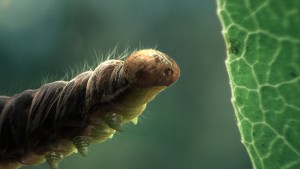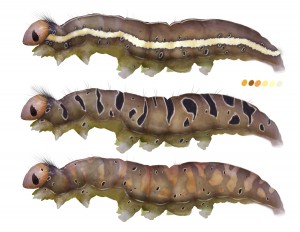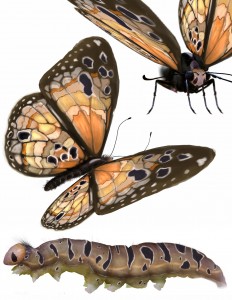Life is hard, but it can work out in the end. That seems to be the basic theme behind ‘Caterpillar,’ a spot for Swedish pension company AMF featuring CG animation and visual effects by The Mill LA. fxguide looks at how The Mill enabled a hero caterpillar to meet his love, lose his love and then transform into a beautiful butterfly.
Directed by Camp David’s Filip Engstrom (working through agency Forsman and Bodensfors), ‘Caterpillar’ was envisaged as an ensemble of mostly all CG woodland creatures inserted into real backgrounds. “Filip and I talked the spot over during a dinner,” said The Mill’s CG Supervisor Robert Sethi, “then he went away and wrote the whole thing and storyboarded it out. At that point we started doing a previs according to the boards – framing and editing that to get the story to work.”
 The Mill’s Jamie O’Hara contributed conceptual art for the caterpillar and butterfly, finding a balance between realism and characterisation. “We started looking at how a real caterpillar looks and then stylised that to be a more cute and likable character,” noted Sethi. “The eyes were interesting because they add a lot of character, but they also make the caterpillar less realistic since they only really have very tiny eyes that sit on the sides of their head.”
The Mill’s Jamie O’Hara contributed conceptual art for the caterpillar and butterfly, finding a balance between realism and characterisation. “We started looking at how a real caterpillar looks and then stylised that to be a more cute and likable character,” noted Sethi. “The eyes were interesting because they add a lot of character, but they also make the caterpillar less realistic since they only really have very tiny eyes that sit on the sides of their head.”
“So what we did was take the markings of the caterpillar on its back and continued them round to the head so there were two markings at the position that the eyes would be. That really worked – you got more of a character that was easier to read and at the same time it still looked realistic.”
Live action plates for the spot were shot on the Spanish island of Majorca by DP Linus Sandgren. Shoot Supervisor John Leonti acquired HDR images and used gray spheres to help the artists get the right intensities and matching light values for the plates. On set a real caterpillar aided lighting and performance reference. “They put him in there and he did a little bit of performance, but after a while I think he got a bit tired,” recalled Sethi. “It still served as a great reference for us to see how he would move and how the lighting would work.”
Back at The Mill LA, the digital hero caterpillar was modelled and rigged in Maya, then brought into zBrush for displacement modelling. “Jamie O’Hara used 8K displacement maps for the body and 8K for the head because some of the shots came so close to camera,” said Sethi. In addition to detailed pores and wrinkles in the caterpillar’s skin, many fine hairs were added through the use of shaders, with hi-res textures created in Photoshop.
 Animator Steve Beck created a rig for the caterpillar that had two binding systems. “One was a general smooth-skin setup where stuff stretched between the joints,” explained Sethi, “and then we had a muscle system that simulated volumes inside of the caterpillar. It was up to the animator to decide for each shot what worked best. We found that the muscle system worked best when doing squash-and-stretch movements. You also get really good secondary animations that way.”
Animator Steve Beck created a rig for the caterpillar that had two binding systems. “One was a general smooth-skin setup where stuff stretched between the joints,” explained Sethi, “and then we had a muscle system that simulated volumes inside of the caterpillar. It was up to the animator to decide for each shot what worked best. We found that the muscle system worked best when doing squash-and-stretch movements. You also get really good secondary animations that way.”
Once rigging was done, and tracking had been carried out on the plates using PFTrack, artists began blocking out the animation in Maya. Noted Sethi, “We were then able to take this rough animation into an Avid right near the animators and put the blocking into a rough edit. Filip and I then continually tweaked the edit to keep getting performances out of the characters until they were right.”
Lighting and rendering was achieved with the help of mental ray and an in-house pipeline tool at The Mill. “It’s basically a really robust cache system,” said Sethi. “We could set up some rough animation and the lighters could take that and get started, then as the animation progressed that could just be sent through the pipeline.”
The Mill’s compositing team, led by Becky Porter, then experimented with ways of dealing with the tricky macrophotography nature of the spot. “For the shoot they used a lot of snorkel lenses,” recalled Sethi, “which creates a real chromatic aberration. If you look in the highlights you’ll see that colours separate out.” Working in Shake, compositors simulated the chromatic aberration, but depth of field proved to be a harder look to achieve. “Faking extreme depth of field can be really expensive,” noted Sethi. “And then you have the caterpillar’s thin hair, which makes the ability to fake the depth of field with Z passes that much harder in the compositing.”
To overcome the depth of field issues, The Mill had a couple of different setups. “For a shot with extreme depth of field that was really close to the caterpillar, we ended up rendering that directly in the CG,” said Sethi. “If you look at the frame, you can see how the depth of field comes around it and you can see the imperfections of the lens. The depth of field disc, or bokeh as some call it, isn’t a perfectly solid colour. It’s stronger at the edge, so we had to replicate that.”
 For the shot of a large frog extending its tongue to eat the female caterpillar, the depth of the field was achieved in 2D. “Here we almost lost the caterpillars in the shot because of the rack focus,” said Sethi, “so we had to push the density of the characters in those shots where they were out of focus. The frog, by the way, was shot on location, but we added a fully CG face and an animated tongue.”
For the shot of a large frog extending its tongue to eat the female caterpillar, the depth of the field was achieved in 2D. “Here we almost lost the caterpillars in the shot because of the rack focus,” said Sethi, “so we had to push the density of the characters in those shots where they were out of focus. The frog, by the way, was shot on location, but we added a fully CG face and an animated tongue.”
Other compositing challenges came from the water and rain in some of the shots. “For the shot of our caterpillar walking next to a pond,” noted Sethi, “you can actually see his reflection in the water and see the water splashing up and refracting the caterpillar. Becky Porter painted out the water splashes and then in 2D refracted the caterpillar back through the splashes when they were put back over him.”
The final shot of the caterpillar morphing into a butterfly and flying away was entirely digital. “In the beginning we had a filmed plate,” recalled Sethi, “but it was so hard to get the correct timing with the camera that we ended up replacing the whole shot. The stone, the flowers, the butterflies were all CG.”
Concentrating on the performance was one of The Mill’s briefs for the spot, while maintaining a high level of realism. “One of the challenges of course was to make it feel realistic,” said Sethi, “but we also had to give this character real emotion so that you felt sorry for him at the end. Everything was story-driven.”
